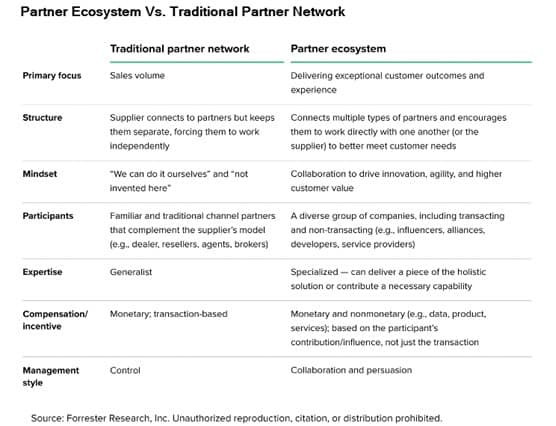A partnership arises when two or more parties agree to collaborate towards a common goal. According to CompTIA, the best business alliances are synergistic, i.e., where the combined capabilities of the alliance are greater than the sum of their separate capabilities.
One observable characteristic of the digital economy is the increased reliance on partner ecosystems – a network of businesses that provide complementary services within a specific industry.
"They add to your skill set, expand your sales footprint, foster innovation, and grow revenue. Everybody wins." Comptia.
FutureCIO spoke to Stephanie Sissler, VP and principal analyst at Forrester, who says when it comes to partner ecosystems, there is a diverse range of partner types (of organisations) – transacting and non-transacting – who work together to help customers achieve their desired outcomes and deliver a compelling, integrated experience, from pre-sale to post-sale.
The chart below provides further detail on the ways a partner ecosystem differs from a traditional channel network.

In defining what a partner ecosystem is (and isn't) she noted the importance of recognising distinct types of partner ecosystems – not all of which are built on a digital platform:
- Co-innovation. Collaboratively developing new ideas, technology and/or products with one or more partners, to address a particular business outcome. A growing subset of this type of ecosystem is a platform ecosystem. This is a supplier solution (either an app or an API/Application Programming Interface) that allows the supplier’s offering to be rapidly extended through partners (and customers) building on top of it. Key examples include Salesforce AppExchange and Atlassian Marketplace.
- Co-selling. A collaborative approach to selling wherein a supplier’s direct sales team and a partner sales team, or a partner sales team and another partner’s sales team, leverage their collective strengths to close an opportunity. A classic example is the Microsoft Co-Sell program.
- Co-integration. Where two or more partners with complementary offerings join forces to craft and deliver customers holistic solutions that help them achieve their desired business outcomes, which may or may not include co-selling. An example is the HPE (Hewlett Packard Enterprise) program (they refer to it as “co-sell”), wherein HPE and HPE service providers “collaborate to develop and deploy enhanced, innovative solutions” to their joint customers.
- Co-marketing. Complementary partners combine their marketing efforts to promote a joint offering or each other’s offerings. An example that is gaining more popularity in B2B sales is an affiliate program. Under an affiliate program, a supplier collaborates with a source their target customer(s) use to obtain information before buying, such as a consulting company or industry blogger.
Asked what are the values that an ecosystem brings to its members, she lists several benefits each type of member gains from being part of the community:
Ecosystem members. The “do-it-yourself” approach of the past is becoming less feasible. Factors such as time-to-market demands, cost and efficiency pressures, increasing solution complexity, and higher buyer expectations, are making collaboration and ecosystems critical to delivering real value to customers, expanding partner mindshare, and propelling business growth.
Customers. All partner ecosystems should be focused on creating superior customer value and delivering an exceptional customer experience. How this is achieved varies based on the type of ecosystem in which a supplier is engaged.
For example, co-innovation ecosystems deliver higher quality solutions faster, co-sell ecosystems provide higher expertise and insights, and co-integration ecosystems reduce product and purchase complexity through the delivery of integrated and seamless end-to-end solutions.
Mitigating the perils of lopsided partnerships
Because not all partners in an ecosystem benefit equally, Sissler warns that partner ecosystems that are not based on a solid understanding of the target customer(s) and focused on delivering them value and an exceptional experience will struggle to achieve and maintain success.

"In today’s ecosystem era, CIOs/CTOs are best served by conducting due diligence to identify and exclusively partner with customer-centric ecosystems that can effectively address their current needs, serve as sources of ideas and innovation that can optimise their IT capabilities, and will leverage their input to fill gaps and address your future needs."
Stephanie Sissler
The more the merrier
The original intent for members of an ecosystem is to provide non-competitive products and services, over time, such exclusivity gets diluted as members expand their portfolio or capability either through organic growth or more recently through mergers and acquisitions.
Sissler concedes that most suppliers have multiple offerings with multiple use cases. And because not all ecosystems are alike, a supplier may want to join more than one depending on their objectives.
"For example, a supplier may want to participate in one ecosystem with one offering and another one for a different offering, or multiple ecosystems with the same offering to expand reach," she called out.
Build your ecosystem
Some enterprises are sufficiently large enough to build their ecosystem of partners to cater for their specific requirements. Sissler does not, however, believe this is necessary.
"Partner ecosystems are not an answer to every business problem. A supplier should consider what they want an ecosystem to accomplish and investigate other options before building one," she added.
"Becoming the orchestrator (the business who builds and “conducts” the ecosystem) might not be the best or the first approach to take. While different depending on the type of ecosystem, orchestration has several core requirements, many of which require changes and investment (refer to the chart below for examples)."
Stephanie Sissler
"Some suppliers will be better served by initially participating in an existing partner ecosystem, where they can bring added value to the existing offering, or where they can learn from," she continued.






